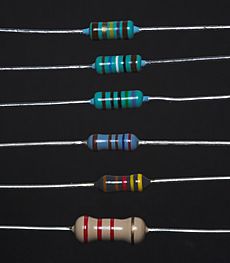Electrical resistance facts for kids
The electrical resistance of an electrical conductor is a measure of the difficulty of passing an electric current through a substance. It explains the relationship between voltage (amount of electrical pressure) and the current (flow of electricity). With more resistance in a circuit, less electricity will flow through the circuit. The inverse of resistance is conductance, a measure not much used. All objects have some resistance, except superconductors.
Resistance, discovered by Georg Simon Ohm in 1827, is the ratio between voltage and current. Ohm's law said that the voltage between any two points in a conductor changes directly as the current between the two points, given the temperature remains the same. He described it with the equation:
which models the ratio, where:
 is the resistance of the object, measured in ohms (Ω)
is the resistance of the object, measured in ohms (Ω) is the voltage across the object, measured in volts (V)
is the voltage across the object, measured in volts (V) is the current going through the object, measured in amperes (A)
is the current going through the object, measured in amperes (A)
Calculating resistance
A long and thin wire has more resistance than a short and thick one. A simple analogy is a road - the more lanes there are, the more cars can go through. The resistance R of a wire with a constant width, therefore, can be calculated as:
where  is the length of the conductor, measured in meters [m],
is the length of the conductor, measured in meters [m],  is the cross-sectional area of the conductor measured in square meters [m²], and ρ (Greek: rho) is the electrical resistivity (also called specific electrical resistance) of the material, measured in ohm-meters (Ω m).
is the cross-sectional area of the conductor measured in square meters [m²], and ρ (Greek: rho) is the electrical resistivity (also called specific electrical resistance) of the material, measured in ohm-meters (Ω m).
Example: Calculate the resistance of copper wire with a radius of 2mm and a length of 5 meters.
Solution:
- The resistivity (
 ) of copper is
) of copper is  Ω m.
Ω m. - The cross sectional area (
 ) is
) is  square meters
square meters - The length (
 ) is
) is  meters
meters
Because: 

Applications
Resistors are used in electrical circuits to provide electrical resistance.
Images for kids
-
A 75 Ω resistor, as identified by its electronic color code (violet–green–black–gold–red). An ohmmeter could be used to verify this value.
-
Running current through a material with resistance creates heat, in a phenomenon called Joule heating. In this picture, a cartridge heater, warmed by Joule heating, is glowing red hot.
See also
 In Spanish: Resistencia eléctrica para niños
In Spanish: Resistencia eléctrica para niños






